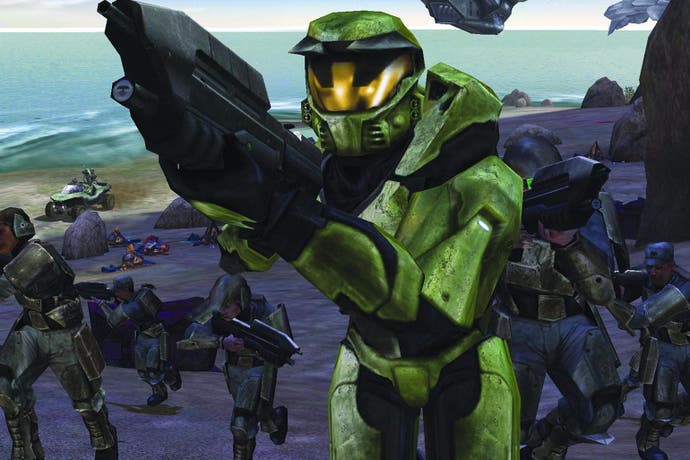DF Retro: Halo - the console shooter that changed everything
The history of Bungie's brilliant shooter, its tech re-assessed, plus the best way to play today.
Every so often a game comes along that changes everything. Games like Doom, Super Mario Brothers and Half-Life aren't just incredible games in their own right - they helped shape the gaming industry as a whole. Halo: Combat Evolved is one such title. As a game, Halo evolved and refined the first person shooter, making it work on a console like never before. As a product, it helped define the first generation Xbox and help Microsoft become the juggernaut of today and, as a project, it lifted its creator, Bungie, into the history books as one of the most revered developers of all time.
At the time of release Halo was cutting edge not just in terms of game design but also in terms of technology, storytelling and features. But the path to release was a long one fraught with challenges and changes that resulted in a product very different from what was first envisioned. To understand its beginnings we need to jump all the way back to 1998 - following the release of Myth: The Fallen Lords, development of a secret project got underway while the rest of the studio toiled on Myth II: Soulblighter. This project was first known as 'Monkey Nuts' but Jason Jones, one of Bungie's co-founders, decided that he wouldn't be too keen on explaining this title to his mother thus it was changed to Blam! - with an exclamation point, of course.
Blam! Started life not as a shooter, rather, as a semi-sequel to Myth - an overhead real-time strategy game focused on tactics as opposed to action. Unlike Myth, however, the engine had evolved to the point where it was possible to utilise fully 3D polygonal models. As detail was added, it became clear that the engine could support more than a simple overhead view, inspiring the team to begin experimenting with third-person shooting.
The first time Blam! would make an appearance in public was at MacWorld '99 where Steve Jobs brought Jason Jones on-stage to introduce the world to Halo. Bungie had been a prolific developer of games on the Mac, after all, and the visuals showcased that day were a massive leap over many other games available at that time. This first look at Halo showcased a very different game indeed but it was tantalising all the same.
Rolling hills and towering bases were shown with a main character resembling what would become The Master Chief running around. The Warthog makes an appearance as well and the physics on display were incredibly impressive for the time. Marines reacted realistically to the bumps and jumps of the vehicle, the antenna swung around and dirt and rubble could be seen spitting up from the tires and colliding realistically with the terrain. The water too was impressive for its day with beautiful specular highlights from the sun and natural wave formations dancing across its surface. It was incredible and this video would up finding its way onto bundled CD-ROMs included with magazines across the country - after all, downloading full length videos from the internet in 1999 was still relatively difficult.
While Steve Jobs suggested that Halo would be released in early 2000, that was not to be, but the game did make at least one more significant appearance that year. It was E3 2000 - the same E3 where Metal Gear Solid 2 blew people away on the PlayStation 2 - and Bungie was there with a brand-new trailer showcasing its progress on Halo. This trailer was cut with cinematic angles but showcased third person gameplay taking play across a massive, detailed world. What was shown this day resembles the final game in many ways but also differs in others. The Warthog was present again, the Covenant were included and even the Chief himself makes an appearance, albeit with a very different, robotic voice - but it's clear that this is still not the Halo we all know and love.
For one thing, the world was shrouded in fog with a limited view distance and filled with wild life and other creatures wandering the landscapes. Weapons look and sound different, Elites speak with a very different voice, the game seemed to focus more on the Marines than the Chief, many of the designs vary in subtle ways and the general mission design is unlike anything in the final game. This build was also used to construct an advertisement for Nvidia's latest graphics card back in the day - The GeForce 2 GTS. Showcasing its shading and rasterising features and high performance, the video depicted the Marines relying on the new graphics card in order to push back the Covenant hoard. An interesting time indeed.
It was around this time that Microsoft's big plans were becoming known - the creator of Windows and Office wanted to get into console gaming with the release of a new system known as the Xbox. It would be based on high-end PC hardware of that day offering a new, advanced experience beyond what the competition could muster. But the success of a new console falls more to software than hardware which prompted Microsoft to being acquiring new talent and games.
Bungie had established a relationship with Take 2 Interactive at this point and both Oni (its third-person action game developed out west) and Halo were planned for PC, Mac and the PS2. Microsoft had other ideas and stepped in, purchasing Bungie and the rights to Halo. Take 2 retained the rights to Oni and Myth but Halo would become a Microsoft game and a key pillar in the Xbox lineup. Many Bungie fans saw this as a betrayal - after all, Bungie had been prolific on the Mac - but it had many benefits for Bungie itself. It offered the development team the opportunity to focus on a single platform which made it easier to refine the experience. It was a tough sell but it was ultimately better for the studio - at least at the time.
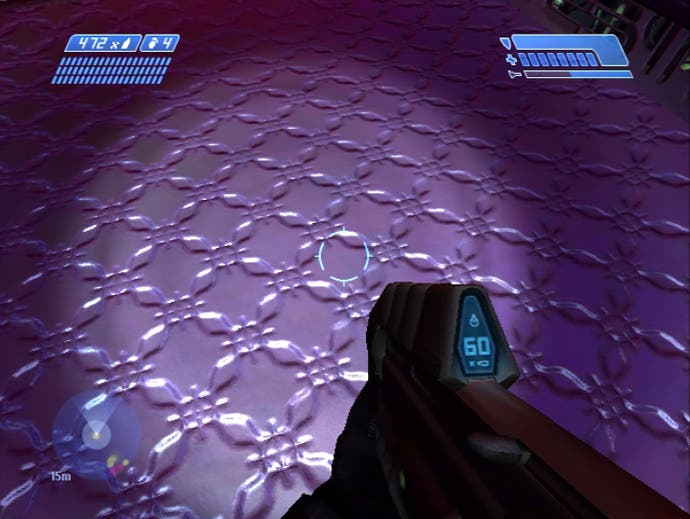
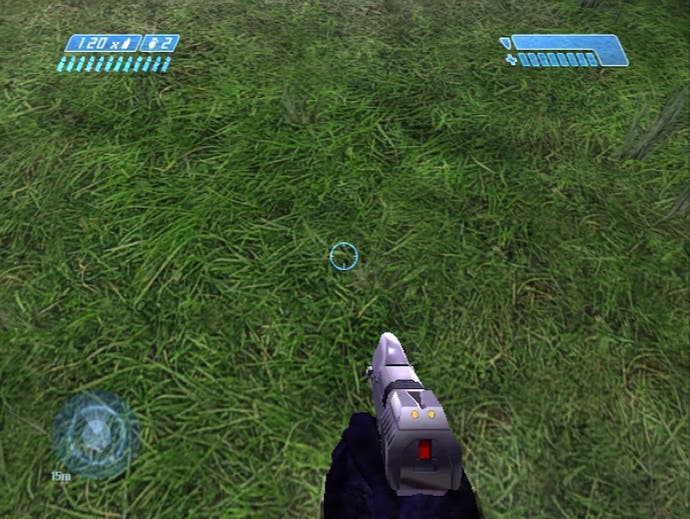

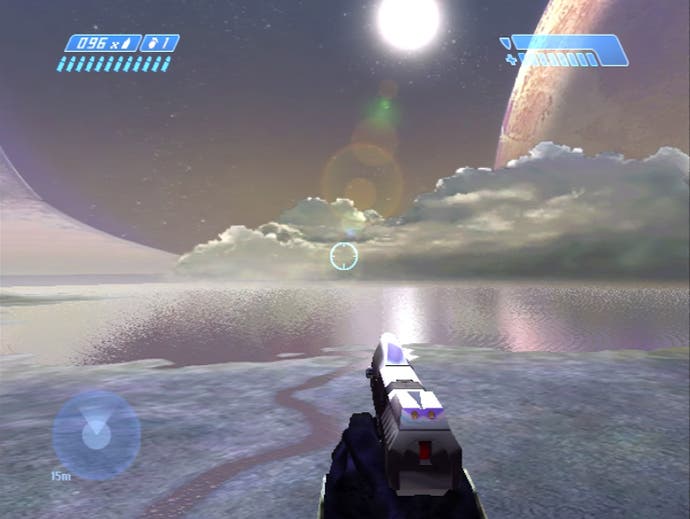
At E3 2001 Microsoft featured the Xbox in a big way and Halo was a part of that. Of course, it wasn't yet a known quantity and its low frame-rate at the trade-show lead some to believe that it might not be a great game in the end. The beautiful and slick Dead or Alive 3 stole the show and Halo was relegated to "maybe" status by many.
The thing to remember about the Xbox and many of its earliest games is that a lot of them didn't really work out. The likes of Azurik, Nightcaster, Bruce Lee, Bloodwake and Obi Wan, all exclusive to Xbox, were generally poorly regarded. None of these games previewed especially well and for a hot minute, it almost felt as if Halo would fall into the same group. Thankfully, that was not the case.
Halo would be released alongside the Xbox in November of 2001 - just three days before Nintendo's newest console, the GameCube would hit North America. Suffice it to say, it wasn't long before the reviews and word of mouth began to spread - Halo was the real deal. It was the game to buy for Xbox on day one. I was among the skeptical, no doubt, but the first time I picked up a gamepad at a local EB Games and played through part of the campaign I knew this was something special.
To understand what makes Halo such a strong game we need to consider its individual pieces - the technology, game design, audio, narrative and rich multiplayer all worked in tandem to deliver a spectacular game.
As an Xbox game, Bungie was able to push Halo to new heights that greatly exceed the previously released footage from the game. It's one of the first game to focus on programmable shaders in a big way, for one thing. Detailed, bump mapped textures, per-pixel dynamic lighting, specular effects and other detailed effects were used throughout the game.

The first time you climb aboard a Covenant ship, the game presents you with alien surface textures that exhibited detail unlike anything we had ever seen at that point. As you walk around with your flashlight engaged, the depth of the bump-mapped textures comes through and the way light plays off each surface is mesmerising. Halo also makes use of high frequency detail texture maps to give the impression of greater detail at close proximity - a feature pioneered in Unreal back in 1998. All told, there was a sense of gritty detail present across surfaces that remains attractive to this day.
Then we have the superb series of skyboxes created for the game - Bungie would become known as masters of the skybox and Halo is its first game to really demonstrate why. Detailed, animated backgrounds were used to build atmosphere - you could see the entirety of Halo itself stretching out across the horizon. Water rippled and stars twinkled - it was an impressive sight. Most impressively, an early form of crepuscular rays was implemented - as the sun passed through trees and other objects, rays of light would leak through in a beautiful fashion.
The immense scale these skyboxes suggested wasn't just limited to non-playable areas. The size of the maps is an achievement as well. Each mission in the game can take 20 to 30 minutes to complete and presents gargantuan areas filled with rolling hills, twisting interiors and large chasms. The game strategically makes use of loading hallways between areas to keep the action flowing but the areas between each loading tunnel could be massive and complex.
Halo, like other Xbox games, also launched with full support for Dolby Digital 5.1 offering gamers true surround sound if you had the gear. Marines and Covenant alike also made use of conditional dialogue - lines recorded and used in a dynamic fashion based on what was happening within the game. The English lines spoken by the Grunts were especially memorable and ultimately the result of a joke - during development, the team inserted lines spoken by Marines and simply sped them up for the Grunts. They were so amused with the results that Grunt English became a thing.
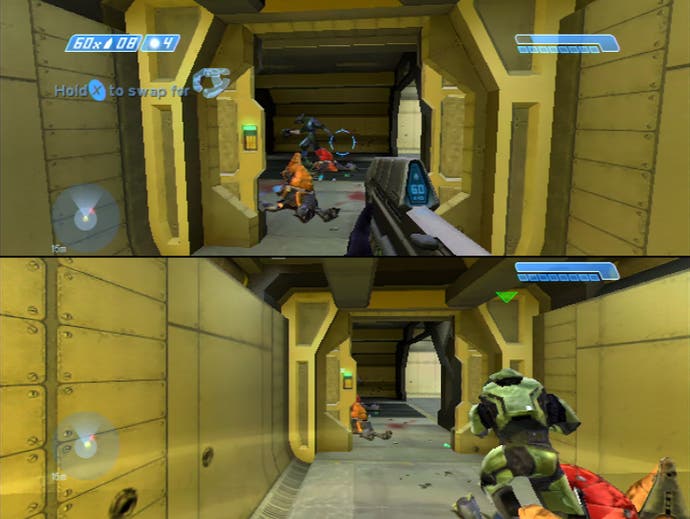
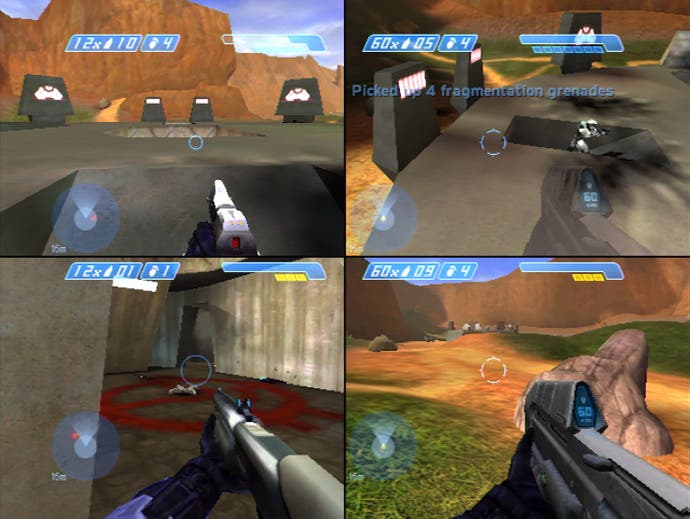
Beyond that, Marty O'Donnell's soundtrack is implemented brilliantly here with tracks weaving dynamically in and out of the game based on what is happening. The themes written and performed for Halo remain memorable to this day.
Then there are the physics - before the days of havoc and other middleware solutions, Bungie had created its own robust physics engine. Vehicles reacted realistically while driving around the world, rubble and dirt kicked up by tires collided with the terrain naturally and those riding within the reacted to the driving model. The famous Warthog jump video that would follow in its wake was made possible by the amazing physics in this game. Gamers become so accustomed to the feel of the game that, upon implementing Havoc in Halo 2, many players felt as if it was a downgrade.
Then there is the AI - enemies react to and challenge players in a way that encourages a very active play style. Even today, these enemies put up a good fight and are interesting to engage. Unlike many other more modern campaigns, where you hide behind cover and take out distant enemies, the Covenant move around the battle field all the time. Of course, being an Xbox game, Halo also supported standard features for the system including 480p but it's not without flaws. Performance is the main issue here. Halo aims for 30 frames per second with vertical sync engaged and proper frame pacing present and, during many scenes, it actually gets there.
Unfortunately, when you step into any large firefight, things start to bog down with dips into the low twenties and sometimes even below. It's best to keep in mind that this was a large scale shooter from 2001. Other first person experiences on consoles at this point were generally much slower in terms of performance or focused on small levels. Halo certainly ran much better than any last generation shooters on Nintendo 64 or the PlayStation as well. In fact, if you look at the raw numbers, it's pretty comparable to many PS3 and Xbox 360 era games as well.
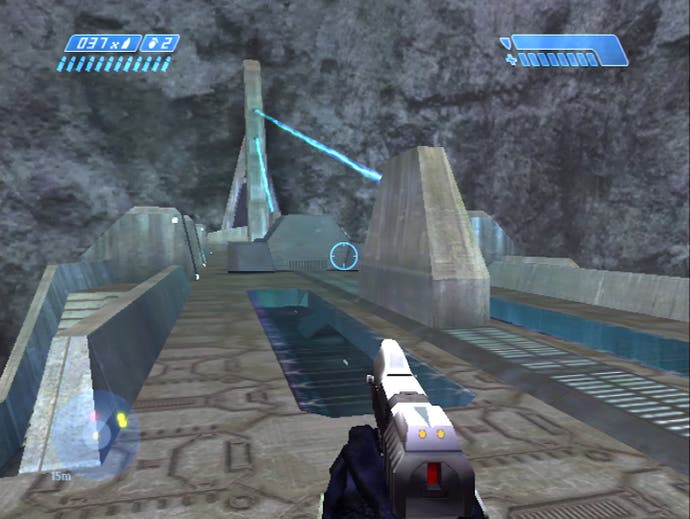
Of course, the campaign was just one way to play Halo - it was also possible to engage in up to four-player split-screen. Impressively, performance here is generally very reasonable. Less complex maps, such as Blood Gulch, manage to run at a very stable 30fps throughout each match only dropping when alpha effects fill the screen.
More complex maps, such as Damnation, don't fare quite as well thanks to additional shaders and more advanced scene geometry. It can drop hard once combat kicks into gear and it does impact the gameplay experience but even at its worst, it's still better than a typical Nintendo 64 title so it was a genuine leap. It's a shame we don't see more games today with split-screen but modern renderers do make this rather difficult.
Lastly, there is the two-player cooperative mode. Being able to play through the entire campaign like this is an amazing feature and the wide field of view helps make it feel quite playable but this is where the frame-rate bogs down the hardest. Even in the first mission aboard the Pillar of Autumn, one of the simplest maps in the game, the performance drops hard and it does impact playability.
Of course, it's not just the tech that helped Halo succeed in 2001 - the core game design behind the game is brilliant. As with Myth, Halo is a game that appears to adhere to the idea of design by subtraction. Extraneous elements are eliminated in favour of a highly streamlined experience. Jaime Griesemer of Bungie is famously known for saying, "In Halo 1, there was maybe 30 seconds of fun that happened over and over and over and over again. And so, if you can get 30 seconds of fun, you can pretty much stretch that out to be an entire game." Of course, there's more to it than that - it's not just 30 seconds of fun that defines Halo, rather, it's how that chunk of gameplay is mixed in with scenario and map design that makes it work.
Halo is often criticized for dull level design but, in reality, I believe that what people are perceiving is a lack in visual variety rather than gameplay variety. Each room or environment in Halo offers a unique, well placed selection of enemies and weapons that plays differently from the last room. It isn't just a random assortment of enemies placed around here - each one of these rooms is designed to challenge the player in different ways and it works. You may cross the same bridge in Assault on the Control Room multiple times - but every bridge battle plays out very differently and is bookended by other unique scenarios. That said, The Library can still be a slog.
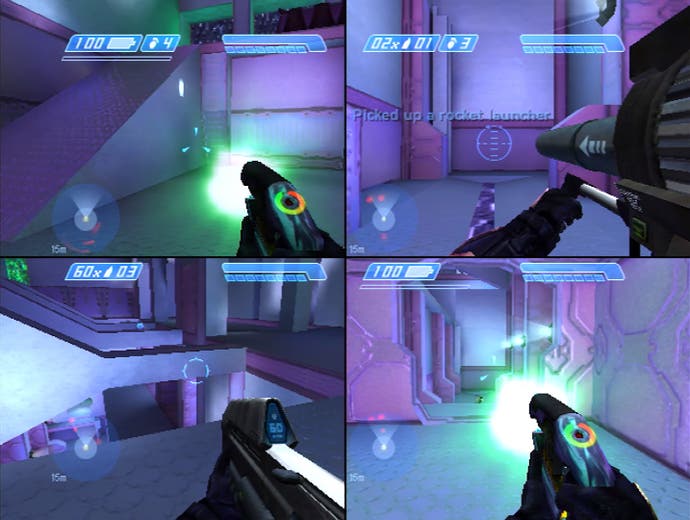
This is combined with the very intelligently design shield and health systems which encouraged players to play differently than in traditional shooters. It made it possible to enjoy on the hardest difficulty, Legendary, by eliminating the need to account for different levels of health for each encounter. Bungie could push player's capabilities to the limit with every battle without worrying that one player might arrive with no health making it impossible to complete. Of course, this system is right for Halo but doesn't mean it should be applied to every game - health packs are still viable.
Halo also focuses on player movement and positioning as well as weapon balance. For instance, different weapons can impact other players or enemies in different ways and knowing how each weapon and power-up behaves was critical. Plasma weapons, for instance, slow the turning speed of players being attacked. Even if the player being pelted by a plasma pistol is holding a shotgun or rocket launcher, the other player can still take them down by positioning themselves in the rear - the plasma fire will make it impossible for the other player to turn around in time. This also impacts vehicles, making is more difficult to quickly move the turret on a tank.
Another example is the Overshield - grabbing this power-up increases the strength of your shield but when you first pick it up, you are granted a very brief moment of invincibility. This can be used to jump from high places that would otherwise kill you, or to shrug off an exploding grenade. This type of thinking helped make positioning and weapon choice central pillars of the game - it wasn't just about getting the most powerful gun, it was about learning how to use all the tools in the toolbox.
Halo also made great strides in making a shooter feel great on a gamepad. The analog sticks were perfectly tuned and subtle auto-aim was used to improve the experience. At the time, there was no other console shooter that felt as good as Halo. On top of that, a focus was placed on alternative attacks - melee, for instance, plays a large role here thanks to its strength. One button grenades were equally important. These systems combined with the limitation of just two weapons also meant that players wouldn't need to fiddle with weapon wheels. Everything you needed was always one button press away.
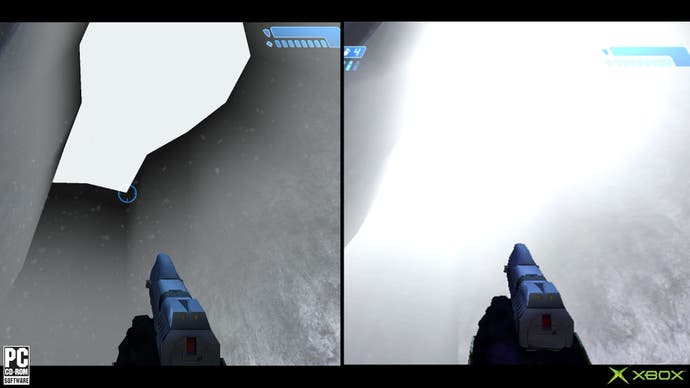
The Xbox did not launch with support for Xbox Live so most players were limited to playing Halo in split-screen mode, but it was possible to link up multiple boxes and create a LAN party of sorts - something many of us arranged back in the day. Beyond that, fans of the game created a utility known as XBConnect that enabled you to use the LAN mode features over the internet for real online player all the way back in 2002. It was a heady time.
Then, of course, there is a narrative - the original Halo tells a simple but tightly-written story that works quite well within the game itself. The main thing here is the twist - the introduction of the Flood remains one of the most brilliant mid-game surprises we can recall. If you played Halo early on with no knowledge of what was to come, the Flood was a genuine surprise. While many have issues with actually engaging the Flood, the way they are introduced remains very special.
Halo was, ultimately, a very special game and the package on offer for a launch title was immense. It was also incredibly successful and helped define the Xbox as a platform. It should come as no surprise, then, that Halo would be ported elsewhere. The first port of Halo comes in the form of Halo for the PC. Handled by Gearbox Software, Halo arrived almost two years after its appearance on Xbox and offered PC players a chance to enjoy the game. At this point, Gearbox spent most of its time porting games to other platforms - Half-Life to PlayStation 2, for instance, and Tony Hawk's Pro Skater 3 to the PC.
The port had a real impact and spawned a large vibrant community but at the same time, it was missing a number of visual features. In 2003, pixel shading was finally becoming common on the PC and this was key in porting Halo to the platform. Halo was best played on a graphics card with full support for pixel shaders.
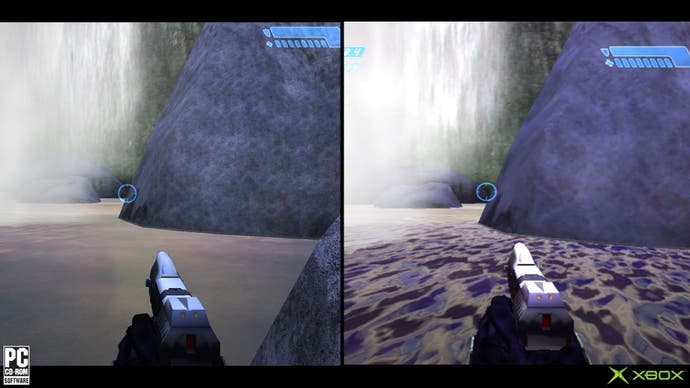
It was actually possible to engage an alternative fixed function mode without relying on pixel shaders at all, of course, but this changed the graphics to the point where it just wound up looking unfinished. Still, with cards such as the GeForce 4MX being sold without the necessary features, it was critical to include a path for less powerful machines.
Of course, even when running at full quality, the PC version still presents some curious issues. All of the game's animation and physics were designed to operate at 30 frames per second and as a result, animations appeared choppy when playing the game at higher frame-rates. Camera movement would appear smooth but animations were limited to 30fps. You can cap the frame-rate to 30fps, of course, but mouse movement feels rather poor in this mode.
There are a lot of missing effects as well. The foggy sky of Assault on the Control Room is replaced with an ugly black border, the skyboxes are missing shading at points, the Assault Rifle lacks its specular layer, water is lacking a key shader and various textures just don't seem to display properly. It just winds up looking somewhat unpolished at times as a result of these oversights.
But where the game really comes alive on PC is the multiplayer and modding. In 2004, Gearbox released the tools used to create Halo content to the community under the name Halo Custom Edition. Now, I don't have a lot of experience with Custom Edition but there is a lot of creativity happening within the scene. Many players have ported over assets or created entirely new ones leading to new maps and modes that barely resemble Halo at all. It's a powerful set of tools and it has resulted in some serious creativity. This is definitely worth checking out. Ultimately, Halo on the PC is not a bad way to play Halo - it has its shortcomings for sure but it also has a lot of advantages that cannot be ignored. Unfortunately, these shortcomings would wind up having consequences down the line.
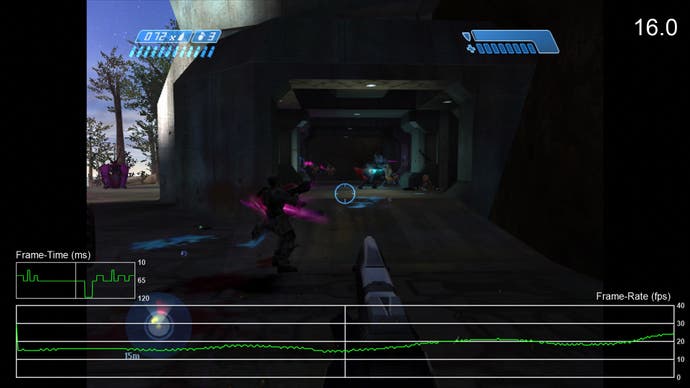
The next way to play Halo comes in the form of backwards compatibility on Xbox 360. You could play the original Halo disc on a 360 and enjoy the game with improved image quality. Unfortunately, the performance also takes a significant hit here resulting in a choppier overall game. It's not a bad way to play Halo but it's better to stick with the original hardware if you have an Xbox.
Bungie would go on to continue developing Halo for years after the original game but eventually sought its freedom from Microsoft. Its final game is Halo Reach but the franchise would continue on Xbox as Microsoft retained the rights to the series. A new studio, 343 Industries, was started up to handle Halo going forward and, while working on the next major installment, Microsoft decided to invest in a full-on remake of the original Halo set to hit stores ten years after the original release of Combat Evolved on Xbox.
It was called Halo Combat Evolved Anniversary - a joint project between 343 and Saber Interactive. Saber used its own graphics engine technology and combined that with Bungie's code to create a unique blend. Halo Anniversary features entirely re-built graphics and enhanced audio alongside the option to play the game using the original Halo assets. You could switch between the two modes on the fly by hitting the back button - it's pretty neat.
However, while enjoyable, there's the sense that this doesn't quite look like Halo any more. It does not blend well with Bungie's original designs and winds up feeling like a different game in many ways. The visuals certainly aren't bad technically though, as many modern rendering features were introduced, including shadow maps and improved shading. It looks more like an actual Xbox 360 game as opposed to an original Xbox game in that sense. Another nice feature is the inclusion of 3D support. Yep, it was released during the era of 3DTVs and fully supports this option. Somehow, more than many other games from this period, Halo works really well in this mode.
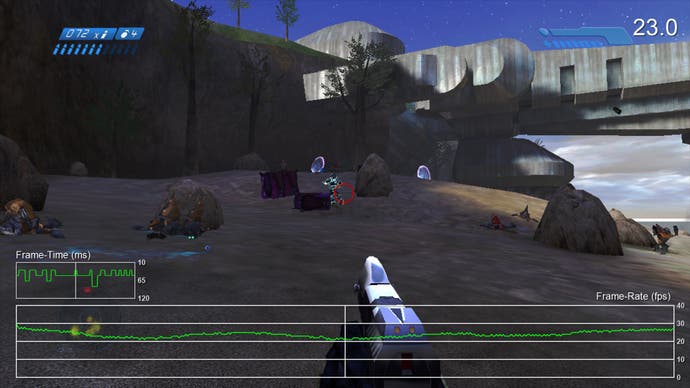
Of course, the real problem with this particular release stems from its performance. In remastered mode, the game regularly drops below 30fps even to the point where it can feel choppier than the original Xbox release. On top of that, it operates with bad frame-pacing giving the impression of even less fluidity. In the classic mode, things improve somewhat but frame pacing issues remain so it still winds up feeling worse than the original Xbox release. Things are even worse in split-screen where performance can drop to very low levels just as we saw on Xbox while the field of view is more limited. It's not a great way to play the game in cooperative mode.
The most disappointing aspect to this release is clearly the lack of proper Halo multiplayer. Many of the original maps were remade but are simply pushed into the Halo Reach engine. It doesn't play anything like regular Halo and, while Reach is great in its own right, this isn't what fans of the original Halo were looking for. Thankfully, these issues would be corrected a few years later on Microsoft's Xbox One console.
In 2014, Microsoft and 343 Industries released Halo: The Master Chief Collection and, while it was notorious for suffering from issues at launch, the port of Halo: Combat Evolved is sublime. The animation work is fixed, many of the visual features are restored and the frame-rate is now a buttery smooth 60fps - at least in classic mode. It's an amazing way to replay Halo today. Even better, all of the original multiplayer maps and features are fully intact and playable in split-screen. This also runs at a stable 60fps and is clearly the best way to enjoy Halo today. The one downside is that the remastered graphics still tend to struggle performance wise on Xbox One.
So while the Master Chief Collection did launch with issues, the iteration of Halo 1 on offer here is excellent. It still could be better, no doubt, but if you're looking to enjoy the original Bungie experience to its fullest extent on modern hardware, Xbox One is the place to be. The icing on the cake? Digital codes for the complete Master Chief Collection are as cheap as £6.99 with just a little shopping around online.
